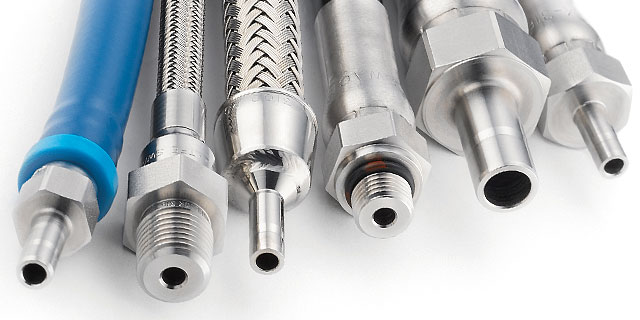3 Steps to Hose Safety

3 Steps to Hose Safety and Lower Costs
Hoses do not get the attention they deserve. Most facilities have specifications and policies concerning tubing, fittings and valves on pressure-containing systems, but not usually for hose.
This is alarming because hoses do fail – for a number of different reasons. For example, they can be improperly routed, or the hose type may not may correctly match to the application. Even with the right setup and hose selection, hoses are subject to wear. Like the tires on your car, they will eventually need attention even if treated well, so a maintenance schedule is a must.
Leaks from hoses should be taken seriously. They can put plant personnel in unsafe situations, inflate operating costs, contribute to fugitive emissions, and adversely affect the environment.
You can avoid dangerous situations and downtime, and improve plant efficiency by following these three steps:
Core Hose Material |
Characteristics |
| Metal |
|
| Fluoropolymer (PTFE, PFA, FEP) |
|
| Silicone |
|
| Thermoplastic (Nylon) |
|
| Rubber |
|
1. Properly Match Hose Type to the Application
Today a lot of companies are trying to get more production from their machines and processes, which can mean greater demands on your hose. In such cases, make sure your hose specifications for pressure, temperature and chemical compatibility are up to date.When specifying a hose, there are four main areas to consider. Choices in these areas will determine your total cost of ownership, which is more important than the initial purchase price.
Learn how Swagelok can help you find the right hose with the right end connection.
2. Proper Hose Routing and Storage
It’s common to have the right hose for the application but install it wrong. An error we see frequently is allowing a hose to hang vertically from a horizontal end connection. In such situations, you should install 90° elbow fitting first. Another set of common installation errors results from improper hose length. Excessive hose length can get in the way, allowing the hose to rub against itself or a machine, accelerating wear. Alternatively, a hose can be too short, tightly stretched between two points. In this case, thermal expansion, system pressure change or slight movement at the connection points can cause leakage at the end connection. The proper hose length is one that that has enough slack to accommodate connection point movement, but not so much as to allow for rubbing, interference, or kinking.When storing hose, here are a few points to keep in mind:
3. Proper Maintenance
Hose failure can be predicted. Based on the hose type and its use, hoses should be checked and replaced at certain regular intervals. You do not need to wait until there is a problem or a dangerous leak.A proper maintenance schedule should take into account the specific application and hose type. (Some hose types wear faster than others.) In addition, these variables will lead to faster wear:
- Repetitive movement (not avoidable)
- Vibration (not avoidable)
- Improper routing (avoidable, explained above under #2)
Conclusion
Hoses are a convenient and quick way to connect two points in your fluid system, but be sure to take the necessary steps to ensure safety and avoid costly downtime. Your Swagelok Sales and Service Center can help you with the three steps above through our Hose Advisory Service or our training course in Hose Essentials.
